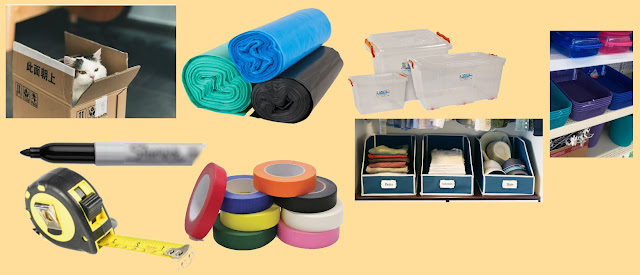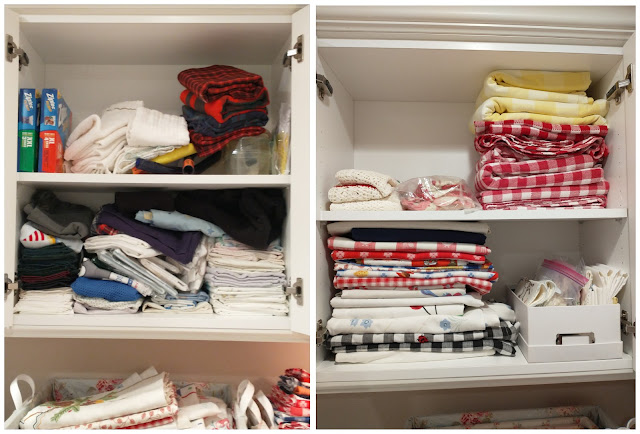6-Step EECDID Decluttering Process
What in the heck does EECDID stand for?!?! Glad you asked!
Evacuate
Eliminate
Consolidate
Designate
In a Crate
Defend the State
EECDID (pronounced "EEK did") is my own goofy acronym for the decluttering and organizing process. I'm posting it here for you just in case you:
- Don't have access to a professional organizer
- Haven't yet read a bunch of books on the topic, and want to try to go it alone;
- Have read some books about how to declutter but haven't yet put any of it into practice;
- Bought the book but haven't gotten around to reading it, and it's sitting on a cluttered shelf...
- Are just curious
Let's start with planning for a decluttering session. When someone works with me, I request a minimum 2-hour session, preferably 4. But my very presence with the client is what may make it possible for her to make it through that period. When tackling it on your own, a 15-minute session, or maybe up to 1 hour, may be the maximum you can manage, whether due to being easily distracted, overwhelmed, difficulty making decisions, physical energy levels, or other external scheduling limitations (work, child care availability, etc).
Remember, you didn't get into this mess overnight, and even with a professional organizer, you aren't going to resolve it overnight, either. So, start small, maybe enlist an organized (gracious) friend to give some moral support, and rejoice in the first step in an ongoing process and your small victories!
You'd be amazed at what you can accomplish in just 30-60 minutes, but start with a single, small project--for example a kitchen drawer, a single shelf, a bathroom drawer, the cabinet above the refrigerator.
Now put a specific date and time on your calendar for this task, and treat it like what it is--an important appointment, with yourself. However, if you take the added step of inviting a helpful friend to work with you, and plan some milk and cookies, that just adds to the fun! 😏
Ready, set, go! Here's how you set up for the EECDID process:
Collect the following in advance:
- Cardboard box(es) for things you are giving away (likely to thrift stores)
- Trash can or bags (for, well, TRASH, but they may also be used for handing off items like clothing/ fabric to thrift stores)
- Big marker, handy for marking boxes "give away", "sell", "move", etc.
- Masking tape (any color will do--I use tape to label boxes or bins that don't need to be "pretty")
- Measuring tape
- If you have any empty baskets/bins that you think might work in the space you're trying to organize, go ahead and add them to these supplies, but DON'T GO BUY ANY NEW ONES YET! (That happens later...) These are not critical to the process, and chances are very good that you already have some kind of storage bins, baskets, trays, etc., in the very space you're working on--as you declutter, more will become available to you. But if not, in order to make the best choice of storage containers, you need to know how much and what size the objects are that you need to store, and the size/shape of the area they'll be living in, so no worries if you don't have anything available at this time.
Set a timer for whatever time you honestly feel you can handle--I'm suggesting 1 hour, but if you feel you can only handle 30 minutes, so be it, and if you can plan for 90 mins - 2 hours, awesome! The density and complexity of clutter in the chosen project will of course affect how long it takes to handle it. But 1-2 hours should be ample time for the example spaces mentioned above.
GET YOUR CAMERA, and take before pictures. I can't tell you the number of times I've failed to do this in my excitement and readiness to tackle a task, and then about 3/4 of the way through I'm booting myself in the butt mentally because I'll have nothing to show for all the hard work I/we have put into the job! Again, TAKE BEFORE PICTURES!!
You'll need some floor /countertop / table space to stage the items you're removing from the cluttered area. From here on, you'll be practicing the EECDID acronym.
E - Evacuate: Take everything out of that space. As you go, undoubtedly you'll find items you haven't used in years, don't like, don't recognize (I call them UFOs) and really just don't want. They should be the easiest to eliminate. Ask yourself the primary decluttering question as many times as you must:
"If this thing were lost or destroyed in a flood or fire, would I replace it?" (...assuming you could, whether it's an "heirloom" or not). If the answer is no, send it out the door.
Note that it will be very tempting, especially with drawers, or a large build-up of paperwork, to just "pick through" the items, pulling out what's an obvious discard item, but not thoroughly examining the entire contents of the cluttered space. When addressing paper, there's a strong tendency to skip over a file, stack or box of paper that seems particularly daunting, but this is usually a mistake. It is sometimes appropriate to hold aside a collection of like items that requires heavy concentration or that is more challenging.....for the next scheduled EECDID session, but skipping it "just for now", is bad organizing policy.
E - Eliminate: Separate the items into appropriate places or groups, i.e.,
- Trash (bag, can, box, etc.)
- Box(es) for giving away--most likely, these will go to a thrift shop of your choice
- Staging area you establish for things you want to sell, via social platforms, consignment shops, yard or living estate sale, Craigslist, etc.
- Boxes/ bins for things that need to move to another room of the house--put these into containers for easier transport to their appropriate location
- Things that are going to stay in the newly organized space.
Breaking this step down further, the goals are:
GOAL #1 Separate everything into:
TRASH, GIVE AWAY, SELL, KEEP
The TRASH group is easy--into trash bags, or the bins, to go out immediately or as soon as the garbage trucks come your way again. Get them out of the house!
The GIVE AWAY group may be a bit more complicated. There may be small appliances, electronics, clothing, decorative items, seasonal items, sports equipment, tools, office supplies, crafting supplies, books...and figuring out the best hand-off solution for all of those different categories of items may mean drop-offs or calling for pickup services, if they exist.
The SELL group has many options! Do you love or hate (organizing and holding) yard sales? If you hate them, do you know friends or family who enjoy them and would be willing to put your things in with theirs or even plan and manage one for you? Do you like or know how to use Craigslist? Are you comfortable with people coming to your home to buy from you? Do you use other social networking or sellers platforms like Facebook Marketplace, Ebay, Etsy? Consider consignment sales for items in really excellent condition, or swap meets, flee market sales, estate sale representatives. Donate items to organizations like Habitat for Humanity, second-hand stores that support particular community services (for Jacksonville FL area, see this post) such as veterans, the disabled, domestic violence victims, food banks, foster care children, pregnant women, animals, people dealing with particular illness (cancer, diabetes, Parkinsons, etc.).
The KEEP pile means it stays in your home, however, it may belong in another room or storage space. Separate these items to be moved to their appropriate location.
Undoubtedly, there will be things you come across that confuse you and you'll be unsure what to do with them. Go back to these questions to help you with decisions.
GOAL #2 Get the eliminated items on their way out. If possible, load them into your vehicle to be taken ASAP to the appropriate location, put trash into trash bins, and move items that belong in another part of the house to their correct location.
C - Consolidate: You hopefully were loosely consolidating items into like-with-like groups as you were pulling them out of the cluttered space, but if not, now is the time to refine it. Combine items that have similar purposes or get USED together
frequently, e.g., coffee making supplies, gift wrapping supplies,
cleaning items, art supplies, baking supplies, sports equipment, office supplies, etc.
Consolidation lets you see how much room you need for objects; whether you need some way to keep items more organized such as a box, plastic bags, bins, etc.; and how large the storage option must be. If you must buy a bin of some kind, try to find at least a temporary container solution to keep order from disintegrating in the meanwhile.
D - Designate Determine where the items will live, their "address" so to speak. That is, on a shelf, in a drawer, getting a new storage container, etc. If you are planning to buy containers for your project, it is very important to measure any drawers, shelf spaces, and cabinet openings, as well as significant corresponding objects being stored, to determine the appropriate container sizes. It's really frustrating to have purchased them, without measuring first, only to discover they won't fit in the designated space, or that they won't hold the intended items.
I In-A-Crate Now put back the keeper items in their intended containers or at least their address, tidy up the staging area by completing goal #2 above, take an AFTER picture or 2, and congratulate yourself! Enjoy your accomplishment.
D - Defend the State
This is the greatest challenge; the last "D" in my organizing acronym is Defend the State, and it's the key to organized, decluttered living. It's self-disciplined maintenance of the system you've created. The heart of that is to put things back where they belong when you are finished with them. Another part of it is being very selective about what you allow in. If you're bringing in a new item, do you have space for it, and a designated location for it? Can you discard something else that it will replace (the 1-in-1-out principle)? If people know you as someone who will accept their discards, you will need to learn to "pass" on the offers--explain that you are trying to simplify your life, or to downsize, or that you have no room for the item, and appreciate the offer, but cannot accept it. There will be a learning curve here if cluttering behaviors have been your habit for a long time.
Here is the Defend-the-State principle in nutshell:
- When you're done with it, put it away;
- When it's dirty, clean it;
- When it's empty, refill it;
- When its usefulness is past, eliminate it





Comments
Post a Comment